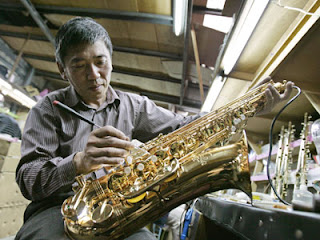If you need something nowadays, typically its easy to get. You simply hop in the car, hit up or Wal-Mart, and in a little while you have what you need. You don't really need to think about how it's made -- unless you're a big fan of "How it's made" on this science blog here...
But even if you worked at the factory that produced whatever you bought, chances you might not have a complete understanding of how the entire product(car) was made. That's because many factories today work using assembly or production lines.
On these lines, workers assemble or produce just one part, day after day even year after year. So, while someone may work for many years at a plant that builds a specific product, they might never have a complete understanding of what it takes to build that product from start to finish.
One of the most interesting and complex that's built in a line system is cars and trucks. Automotive production lines revolutionized the automotive industry, as well as American life. They made building cars more efficient. Because of the increase in the efficiency the cost to produce cars went down and when production cost were lowered, so was the retail price of the cars. This price reduction meant more people could afford to buy a vehicle on their own.
Production Lines.
Production lines seem like something that sprang up at the turn of the 19th century, but they've actually been around for longer than that. Basically, a production line uses a division of labour. In a division of labour system, instead of one person doing an entire job from start to finish by themselves, everyone takes the small piece of the job, bringing the smaller parts until the work is done.
 |
| Perfection is an art |
But for most of human history, if something has to be built or crafted, one person will make it from start to finish. Skilled craftspeople perfected the art of making one particular product. They'd train others to do the same work, taking the product from start to finish. once the product was complete, the craftsman could then trade the finished product for other goods that he or she needed.
The only problem with this system is that it's very time consuming.
Modern Automotive production lines
What's striking about modern automotive production lines is that they haven't changed all that much from the basic Ford system from long ago. The cars still come to the workers at individual work stations, each worker performs a specific task and when all the tasks are done, at the end of the line, you'll see brand new ready-to-drive cars rolling off the assembly lines.
Alternate Automotive production lines
One of the problems that car companies have constantly run up against in automotive production lines is how to keep the workers happy and interested in the products what they build. Alienation is a common problem for production line workers because the task they perform can often be boring or repetitive. Some may also not feel like they have any ownership or stake in the product they're building.
Toyota's method of production and assembly helps address that problem. Toyota factories in Japan are designed to be happy places, where automated delivery cars play cheerful songs as they go by. If a worker spots a problem, he or she is encouraged to stop the production line and fix it -- even though stopping and starting is very expensive.
 |
| A toyota Motor Corp. |



No comments:
Post a Comment